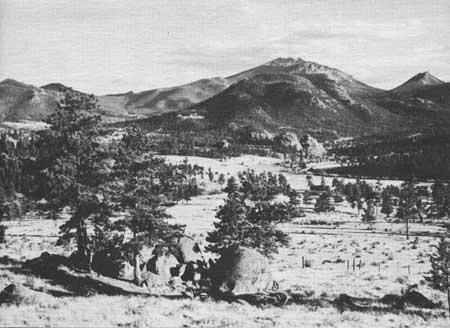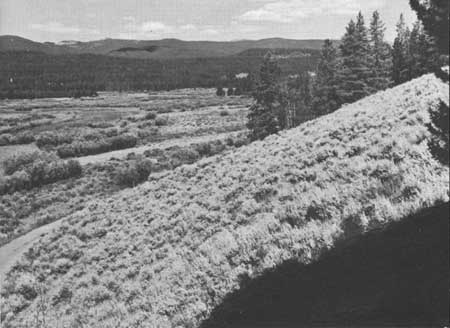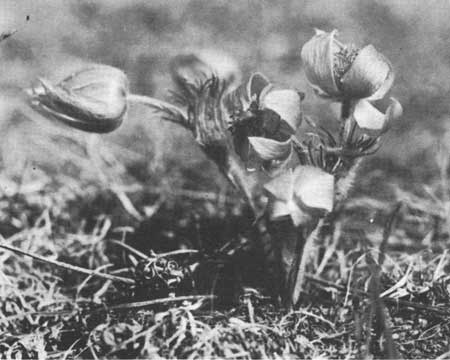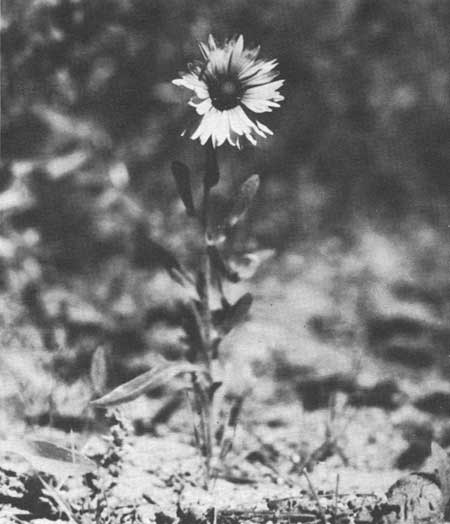|
ROCKY MOUNTAIN National Park |
 |
Plant Communities
BELOW 9,000 FEET
In the lower slopes of the park, below approximately 9,000 feet altitude, usually described as the Montane Zone, the climate is relatively warm and dry. This type of climate has encouraged a fairly consistent pattern of vegetation that may be considered climax. The forests in this zone are open. The trees are likely to be scattered in characteristically parklike stands and are made up mostly of ponderosa pine, but on cool north slopes the stands are thicker, with Douglas-fir sprinkled in or even dominant. With the ponderosa pine on drier sites is juniper (commonly called cedar), and above 8,000 feet sometimes thick stands of lodgepole pine are admixed. Along the streams are the distinctive and graceful Colorado blue spruce, associated with willows, birch, and alder. Aspen groves and, in lower altitudes, cottonwoods appear here and there. Many types of bushes, some characteristic of the foothills, grow in the Montane Zone.
The most characteristic forest tree of the lower part of this zone is the PONDEROSA PINE (Pinus ponderosa). It has dull-green needles from 3 to 6 inches long—longer than those of other pines in the park—which are usually in bundles of three. Although the bark on young trees is black, the mature trees have a yellow-brown bark in characteristically rectangular plates. The cones are about 3 inches long, which prickles on the tips of the cone scales. Capable of growing in warm, dry environments, it is an evergreen of south-facing slopes and is widespread as a forest tree in the southwestern United States. On the cooler, north-facing slopes, the DOUGLAS-FIR (Pseudotsuga menziesii) mingles with the ponderosa pine. The Douglas-fir is easily distinguished by its needles, which grow singly along the branch instead of in sheaths. The needles are flat, blunt, about 1 inch long, and have a narrow stalk at the base which pulls off with the needle. This distinguishes it from the blue spruce often found in the same vicinity. The bark is smooth and gray on young trees, but rough, brownish, and deeply furrowed on older trees. The cones are about 2 inches long, made up of broad scales each with a projected 3-pronged bract. Here, the Douglas-fir seldom attains the great size for which it is noted in the Pacific Northwest.
Another conifer growing in this zone, usually along streams or in such other wet locations, is the BLUE SPRUCE (Picea pungens), one of the most admired evergreens of the West. Its needles produce a bloom, or powder, which gives the tree a distinctive bluish or silver aspect, especially noticeable in midsummer. The cones are from 3 to 5 inches long, tan-colored, with many scales which end in a narrow tip, but without a prickle.
In the upper parts of the Montane Zone, the LODGEPOLE PINE (Pinus contorta) forms dense forests. This tree gets its name from the use which was made of it by the Indians for tepee (or lodge) poles. It is characterized by tall, slender, straight trunks, with most of the foliage near the top. Its trunk is usually much smaller than the other conifers of the region—seldom exceeding 20 inches. The bark is much thinner than that of the ponderosa pine, with gray scales on young trees which become brown with age. The cones are about 2 inches long and are borne in clusters of 2 or 3, tightly attached to the branch. The cones often remain on the tree for years, the seeds retaining their vitality. After a light forest fire, the undamaged cones will open, releasing the seeds. This is Nature's way of reseeding a fire-swept area and explains the extremely dense stands of lodgepole pine which, for example, you will see near Many Parks Curve.
 OPEN STANDS OF PONDEROSA PINE ARE TYPICAL OF THE LOWER PORTION OF THE PARK. |
ROCKY MOUNTAIN JUNIPER (Juniperus scopulorum) may be seen on dry hills and rocky canyon walls in the park. Its scalelike leaves (not needles) are small and flattened against the innumerable branches. It has no cones, but bears little, bluish berries, which require two seasons to ripen. Usually this juniper grows in a squat and sprawling manner.
The most common deciduous tree in the park is the QUAKING ASPEN (Populus tremuloides). It is immediately recognized by its smooth, white bark and its small, green leaves which tremble with the slightest breeze, because of the curious flattening of the petiole at right angles to the leaf blade. Aspen grows to considerable size in beautiful groves of tall trees, where the moisture and shelter are sufficient, but is more often seen in scrubby thickets on rocky, drier slopes. In September the leaves turn to a golden color, giving early autumn travelers a match less visual experience. The NARROW-LEAF COTTONWOOD (Populus angustifolia) grows along streams in the lower altitudes of the park. Many willows also occupy stream-bank environments, the most common being the SCOULER WILLOW (Salix scouleriana), with characteristic willow leaves and large oval catkins which are quite conspicuous in May and early June.
WATER BIRCH (Betula occidentalis) is a thin-leaved, graceful shrub, sometimes growing to tree size, commonly seen along streams in the lower forests. It can be recognized by its graceful, almost delicate, appearance. THINLEAF ALDER (Alnus tenuifolia) is also abundant along streams, with the birch. It often grows in great clumps, over-hanging the streams, with many stems growing from the same root. Widespread throughout the West, the alder provides habitat for many bird groups. You may also recognize, by its leaf, the ROCKY MOUNTAIN MAPLE (Acer glabrum), which grows here and there in the park up to about 11,000 feet altitude. It is a distant relative of the sugar maple of the East.
The shrubs most commonly observed by the visitor are:
ANTELOPE BITTERBRUSH (Purshia tridentata)—A low, tough, much-branched shrub, with many fragrant, pale-yellow blossoms in May and June. Its leaves are less than 1 inch long, wedged-shaped and 3-toothed at the apex. The spindle-shaped seeds are important food for chipmunks and ground squirrels, and mule deer depend on the shrub for browse. BOULDER RASPBERRY (Rubus deliciosus)—A common bush with showy, 5-petalled white blossoms, up to 3 inches across. During May and June this shrub adds much beauty to the landscape. The berries are eaten avidly by birds. WAX CURRANT (Ribes cereum)— A common shrub found also in the highest forests. It forms rounded clumps, 1 to 3 feet high, with rigid, much-branched stems and rounded leaves. The red berries ripen in summer and are eaten by many birds and small rodents. This plant is alternate host to blister rust (a disease which may affect the limber pine in the park in the near future), and much of it has been eradicated in areas where limber pine grows. SAGEBRUSH (Artemisia tridentata) is a familiar plant in much of the West. In the park, it grows in a dwarf form, and is common in Glacier Basin and on the southwest slopes of Deer Mountain. This woody shrub, about 1 foot high, with 3-toothed, wedge-shaped, silvery leaves, is good forage for mule deer.
 SAGEBRUSH IS ONE OF THE SHRUBS HEAVILY BROWSED BY MULE DEER. |
Conspicuous wildflowers which grow below 9,000 feet in the park and which will attract the visitor's attention in their blossoming season are:
Early in the season—as early as March—the PASQUEFLOWER (Anemone patens) exhibits its large lavender blossoms as a sign of spring. As the season advances, its blossoming follows the melting snow up the mountain slopes, where it may be seen into July. This flower, without petals (the sepals resemble petals) but with a gold center, looks somewhat like the garden crocus. It is covered with silky hairs—almost "fur-covered." Another early bloooming flower is the COMMON STARLILY (Leucocrinum montanum), commonly known as sandlily, which displays narrow grasslike leaves and white, stemless flowers in early spring. It is rare in the park, but abundant near the village of Estes Park during May.
 THE SPREADING PASQUEFLOWER HERALDS THE ARRIVAL OF SPRING. |
The STEMLESS TOWNSENDIA (Townsendia exscapa), locally called Easter-daisy, is another early bloomer—most abundant in May. The inch-wide flower heads are pale pink or white with yellow centers and are clustered on the crowns of the plant. It is one of the Composite Family and is easily recognized by the general similarity of the flower heads to those of the larger, taller oxeye-daisy. The arnicas have several representatives in the park region. An early blooming variety is the HEARTLEAF ARNICA (Arnica cordifolia) which is common in the moist fields and open ponderosa pine forests in May and June. It has large, yellow composite blossoms, from 2 to 3 inches across; the heart-shaped leaves are best developed at the base of the stem. ROCKY MOUNTAIN IRIS (Iris missouriensis) is common in meadows of this zone, with its light-blue flower adding color to the "parks" of the region where moist conditions permit. THERMOPSIS, or GOLDEN BANNER, (Thermopsis divaricarpa) colors the open areas with yellow during June and July. This common plant is a pea, as its flowers suggest, and as the long, flat seed pods prove. The flowers appear in clusters along the top of the stem. The PLAINS ERYSIMUM (Erysimum asperum), better known locally as western wallflower, is also yellow, common, and conspicuous during June and early July. Sometimes mistaken for the golden banner by visitors who drive rapidly past the meadows, it has quite a different flower pattern, being a mustard with spikes of many small 4-petalled flowers.
 THE GAILLARDIA IS ONE OF THE SHOWIEST COMPOSITES. |
As summer advances, other flowers become abundant. The penstemons present their showy purple spikes of flowers during July. Most abundant and conspicuous is the TALL PENSTEMON (Penstemon unilateralis), usually a foot or more in height, which often colors the meadows blue. All the penstemons are easily recognized by their lobed, generally bell-shaped flowers. The common name beardtongue is applied to certain species which have a flattened and bearded sterile stamen on the inside of the flower tube. This fifth sterile stamen, whether smooth or bearded, is the source of the generic name Penstemon. The LAMBERT CRAZYWEED (Oxytropis lamberti), also known as Colorado locoweed, is abundant through July. It can be recognized by its spike of reddish-purple blossoms and the narrow pinnately compound leaves. Curiously enough, the locoweed blooms twice during the summer, the August period of blossoming being less noticeable. The FREMONT GERANIUM, or wild pink geranium (Geranium fremonti), is a lovely plant of the open pine forests, with typical 5-petalled pink geranium blossoms. The common perennial GAILLARDIA (Gaillardia aristata) is a showy composite. The flower heads are 2 to 3 inches across, with deep-maroon to brownish centers and bright-yellow rays, often with dark bases. The tips of these ray flowers have three distinct indentations, serving to help distinguish this plant from the BLACK-EYED-SUSAN (Rudbeckia hirta), which is also common in the mountain meadows.
FIREWEED (Epilobium angustifolium), as its name suggests, commonly blooms on areas devastated by forest fire or other destructive agencies. Its silky seeds are easily carried by the wind to these areas, where it becomes dominant. It blooms from early July into September, and the deep-pink, 4-petalled flowers are borne in long graceful spikes. It is a common roadside plant. MINERS' CANDLE (Oreocarya virgata) is a hairy-stemmed plant with innumerable close-set clusters of small, white flowers throughout its stout, straight stem. It also is common along roadsides.
Autumn flowers become increasingly abundant in the late summer. Conspicuous are the shrubby composites and types of sunflowers. They include several kinds of groundsels, some sunflowers, and purple asters. While the peak of the flower display comes during July for this lower zone, many attractive wildflowers can be seen until mid-September.

|

|
| NPS History | History & Culture | National Park Service | Contact |
|
Last Modified: Sat, Nov 4 2006 10:00:00 pm PST |


